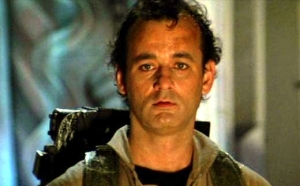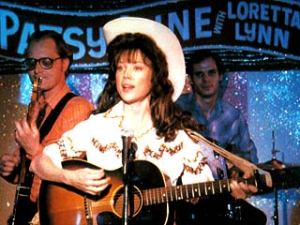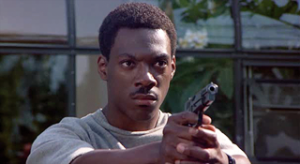AFI: Eighties-ized: 100 Years… 100 Stars!
In 1999, the American Film Institute released its list of the top 50 screen legends of the 20th century (25 male and 25 female movie stars were included). Keeping up with Retrobacktive’s 80s-themed AFI series, this countdown showcases the top ten male and top ten female actors whose rise to stardom reached heights of unparalleled glory in the 1980s.
Some ground rules: Each actor had to have released one major motion picture before 1985; television roles do not count. Credit is not based solely on award nominations, but a collective overview of accolades, box-office draw, and cultural relevance (i.e. performances still referenced in current media).
Opening this series are…
-10-
Bill Murray – Before denouncing Retrobacktive’s countdown based upon Bill Murray’s (relatively) low entrance,remember: A) he still made it on here, and B) there was a solid four-year period between 1984 and 1988 where Murray remained virtually absentee from Hollywood. It’s impressive he made the list considering his disappearance for over a third of the decade. But Ghostbusters is also impressive. As is Caddyshack. And Scrooged. And he’s Bill Freakin’ Murray. Signature Role: Dr. Peter Venkman in Ghostbusters.
Sissy Spacek – When it takes more than one hand to count someone’s Oscar nominations for leading roles, her inclusion on any screen legends’ list hardly needs justification. While no longer courting the limelight, Spacek was a perennial Academy Award nominee during the 80s, capturing four nominations between 1980 and 1986; she won in 1980 for her role as Loretta Lynn in Coal Miner’s Daughter. Signature Role: Loretta Lynn in Coal Miner’s Daughter.
-9-
Emilio Estevez – The de facto leader of the Brat Pack, Estevez eschewed the stage moniker his father adopted in favor of his familial surname. His characters, however, reflected less of his heritage but a great deal of range, from an L.A. slacker-turned-repossession-agent to a bumbling cop to a legendary outlaw. Estevez had a knack for playing against type, a quality that helped set him apart from his MTV-generational colleagues. Signature Role: William H. Boney in Young Guns.
Sean Young – If going bat-shit crazy is a common theme among 80s film stars (read further along), it fits to start early with the most literal example. Young, who was originally cast in Tim Burton’s Batman, was cut from the film after breaking her arm, and replaced by Kim Basinger. When it was revealed that Burton’s much-anticipated follow up, Batman Returns, would include Catwoman, Young made her intentions for the role clear by appearing on talk shows (unscheduled) in a home-made Catwoman costume. Burton was either unimpressed or scared… or both. Michelle Pfeifer was cast instead, and Young’s once promising career began a rapid decent into obscurity. But she did star in Blade Runner, which almost makes up for it. Signature Role: Rachael in Blade Runner.
-8-
Eddie Murphy – In the early 80s, Saturday Night Live had fallen from being a breeding ground for young, comedic talent to a direction-less parody of its former self. The only ray of light to emerge from this era was Eddie Murphy. Though a regular cast member on SNL from 1980 to 1984, Murphy’s popularity rapidly spilled over into the world of film with his debut in the 1982 cop-buddy pic 48 Hours. A year later, Murphy starred alongside Dan Aykroyd and Jamie Lee Curtis in Trading Places. The success of this film made Eddie Murphy a household name, and ultimately led to his starring role in Beverly Hills Cop after Sylvester Stallone dropped out. Beverly Hills Cop was the biggest film of 1984, and skyrocket Murphy to worldwide acclaim. It was followed up with a further string of hits that included The Golden Child, Coming to America, and Beverly Hills Cop II. Like many of his peers, Murphy’s career has been alluvial since the 80s, though he has found recognition among a new generation as the voice of Donkey from Shrek. Signature Role: Axel Foley in Beverly Hills Cop.
Demi Moore – While her heyday was arguably the 90s, Moore managed to establish herself quickly as the “It” girl of the Brat Pack’s female collective. Despite her association with the group, Moore remained something of an outsider, which ultimately proved strategic in maintaining success past the Brat Pack’s popularity. Nothing, however, could save her from Striptease. Signature Role: Debbie Sullivan in About Last Night…
-7-
Sylvester Stallone – No one can argue the string of duds Stallone put out in the 90s, but in the 80s he was the closest thing Hollywood had to John Wayne. There isn’t a single role between 1980 and 1989 where Sly doesn’t play an overt, brooding tough guy (yeah, even Rhinestone, when you think about it). It became laughable as an eventual caricature, but not many actors can pull off lines like “You’re a disease. And I’m the cure” with such plausible sincerity. His collective body of work during the 80s is not only prolific, but upon reexamination quite good. Crazy as it may sound, Stallone just may have been ahead of his time. Signature Role: Rocky Balboa in… well, any of ’em.
Meryl Streep – To be fair, Meryl Streep almost did not make this list. As a more than reasonable contender for the title of greatest living actor, Streep transcends an acme of success restrained to one decade. But then you gotta think Silkwood, Ironweed, Out of Africa, The French Lieutenant’s Woman, A Cry in the Dark, Sophie’s Choice, the endless nominations, and the indelible legacy she built during the 1980s. She may be a timeless icon of cinema, but it’s hard not to look at a filmography from the 8os and not think, Damn, what wasn’t this woman not in? Signature Role: Sophie Zawistowski in Sophie’s Choice.
-6-
Mel Gibson – Imagine this: you help propel the most successful movie ever produced in your adoptive home country to global acclaim; you play the lead in the greatest “buddy-cop” movie ever made – a sub-genre that would dominate the action film arena for the next two decades; then you make Braveheart; then you go insane. Who cares? You’re still Mad Max. Time and lucidity may not have been so kind to Gibson, but as arguably the most popular leading male in the 80s, there’s a lot Mel can be forgiven for. Just not Air America. Signature Role: Max Rockatansky in The Road Warrior.
Kim Catrall – Acting chops are irrelevant (though her’s are fine). Catrall cemented her legacy in the hearts of every Gen Y boy by bringing life (pun intended) into the world’s sexiest mannequin. While Mannequin didn’t win over critics, it provided the indelible fantasy of being locked in a department store playland at night with a beautiful woman. In addition to Mannequin, Catrall played numerous vixen-like characters in movies such as Porky’s, Police Academy, and Big Trouble in Little China. Signature Role: Emmy Heshire in Mannequin.
-5-
Michael Keaton – Controversy abounded when Keaton was selected to play Bruce Wayne/Batman in Tim Burton’s live-action production of the famous DC Comics character. At the time, Keaton was known for his comedic fare in films such as Mr. Mom and Gung Ho. The casting proved fruitful as Batman broke many opening-weekend box office records, with Keaton’s quirky portrayal particularly lauded. Keaton’s star continued to rise, not only based upon his nuanced performances, but also for his reputation as one of the most charismatic guests on television talk shows. Signature Role: Beetle Geuse in Beetlejuice.
Whoopi Goldberg – Surprisingly, Whoopi Goldberg is something of a late-comer to the 1980s film scene – though she made the 1985 cutoff. It was, however, this year that her prowess as a serious actor was put on display in The Color Purple, which earned Goldberg an Academy Award nomination. But it was the string of comedic hits to follow that made Whoopi a household name, including Jumping Jack Flash and Burglar. And of course, there’s her EGOT (Emmy, Grammy, Oscar, Tony awards collection). Signature Role: Terri Doolittle in Jumping Jack Flash.
-4-
Patrick Swayze – A tragic loss by any standards, Swayze left a void in Hollywood that will likely never be filled. In the 80s, Patrick Swayze was all things to all audiences. A dashing heartthrob in Dirty Dancing; the baddest bouncer on the planet in Road House. He at once charmed and dazzled female moviegoers yet impressed male viewers with his restrained toughness. It is a rare quality demonstrated by an elite few in cinema; Swayze undoubtedly earned his rank among the likes of James Dean, Paul Newman, and Robert Mitchum. Signature Role: Dalton in Road House.
Kathleen Turner – She wasn’t bad; she just sounded that way. Kathleen Turner may have worked hard to steer herself from being typecast as a femme fatale, or the embodiment of Gen X’s Lauren Becall, but with the most sultry voice in cinema, and a film debut that would make Rita Hayworth blush, Turner was primed to be one of the decades biggest stars. She found multiple award nominations for her work in films such as Prizzi’s Honor, Romancing the Stone, and Peggy Sue Got Married. Despite her promising career, Turner quickly fell out of the spotlight in the early 1990s, owed to a debilitating struggle with rheumatoid arthritis, severe alcoholism, and a reputation for being difficult to work with. Since then Turner has remained active in theater, television, and working in support of Planned Parenthood of America. Signature Role: Matty Walker in Body Heat.
-3-
Arnold Schwarzenegger – There may have been no bigger star in the 80s than Arnold, literally. The former Mr. Olympia made his feature film debut in the campy Hercules in New York goof-fest. But it wasn’t until 1981’s live-film adaptation of Conan the Barbarian when Arnie finally got the starring role that put him on the action-film map. And from there the future Californian governor dominated the breakout film genre of the decade. Signature Role: T-800 Model 101 in The Terminator.
Molly Ringwald – Emilio Estevez may have been the Brat Pack’s leader, but Molly Ringwald was undoubtedly Brat Pack auteur John Hughes’ fair-haired child in the 80s. Ringwald served as the cornerstone of the seminal 80s actors collective, portraying standout characters in The Breakfast Club, Sixteen Candles, and Pretty in Pink. Widely considered the greatest teen star of all time, Ringwald’s ubiquitous Hollywood presence waned in the 90s, but her career eventually came full circle after landing the role of mom Anne Juergens on ABC Family’s The Secret Life of the American Teenager. Signature Role: Andie Walsh in Pretty in Pink.
-2-
Michael J. Fox – In an earlier post, Retrobacktive named Michael J. Fox the definitive actor of the 80s. But a significant component of Fox’s universal popularity was his deft portrayal of conservative yuppie Alex P. Keaton on Family Ties. Following AFI’s exclusive cinematic theme, Fox’s Emmy-winning television work is omitted from consideration, yet that only holds the Canadian actor at the number two spot. Fox effortlessly transitioned his small-screen career into cinema stardom with the runaway success of Back to the Future. Audience pleasing leads in The Secret of My Success and Bright Lights, Big City also contributed to Fox’s meteoric rise. Though stricken with Parkinson’s Disease since the early 90s, Fox has continued to maintain a successful presence on television, though his last major film release was over 16 years ago in The Frighteners. Signature Role: Marty McFly in Back to the Future.
Sigourney Weaver – The six toughest words from any 80s movie: “Get away from her, you bitch!” And if you think it would have held the same guttural authenticity with any other actor, remember this: Weaver was actually nominated for an Academy Award for her role in Aliens. That’s right; she carried a grizzly sci-fi action romp to the stuffy 80s Oscar party. If that weren’t enough, she also played the female lead in the greatest 80s movie, Ghostbusters. Then there’s Working Girl, and Gorillas in the Mist, which earned Weaver Best Actress and Best Supporting Actress awards at the 1988 Golden Globes, the first person to ever win both in the same year. Signature Role: Ellen Ripley in Aliens.
-1-
Tom Cruise – If a Gen kid (a “Gen” is either a member of Generation X or Y, and comprise the youth of the 80s) could create a cinematic soundtrack to accompany his or her autobiography, you might hear kitschy lines from Tom Cruise at every moment. Virtually every film from the first decade of Cruise’s career is culturally poignant in some way. From his early roles in The Outsiders, All the Right Moves, Risky Business, and Legend, to maturing work in The Color of Money, Rain Man, and Top Gun. Cruise then capped off the decade with a shining performance as paralyzed Vietnam vet Ron Kovic in Born on the Fourth of July, earning his first Golden Globe award for Best Actor and first Academy Award nomination. While his personal life has comprised a generous portion of his celebrity for the past 20 years, Cruise’s popularity at the box office has never waned. In 2012, he was still the highest paid actor in Hollywood. Signature Role: Pete “Maverick” Mitchell in Top Gun.
Phoebe Cates – She has never been nominated for an Oscar. And her filmography is modest compared to many of her contemporaries. But remembering the 80s is more than just picking the “biggest” people and moments from it (okay, it’s sorta that); it’s about remembering! Put yourself back in that time and try to recall who or what was on everyone’s mind. Certainly Gremlins. Despite its controversial content, the film was a huge success. But if your memory needs further jogging, go find a music file for The Cars’ “Moving in Stereo.” Play it. What comes to mind? If you’re a guy over the age of 30, it’s one scene from one film in particular. Is this worthy of the number one spot on this list? No. But Fast Times at Ridgemont High and Gremlins is! Signature Role: Kate Beringer in Gremlins.








